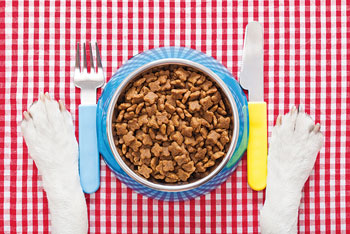By Katie Volat, DVM, Capitola Veterinary Hospital
The pet food industry has made progress in the quality and variety of ingredients available, however, it is still quite difficult to decipher pet food labels. Avoid marketing ploys the next time you hit the pet store by learning a few of the following tips. As an informed consumer, you can ensure you are providing the best nutrition for your pet while getting the best value for your dollar.

Organic, premium, natural, and gourmet are all descriptive terms used in pet food labels. Unlike human food, pet food can state “organic” on the label without official FDA or USDA certification, as is required with human food. None of these descriptive terms equate to better quality or special ingredients, so compare carefully before you purchase a food with a premium price tag.
Is grain free important? Yes. Grain-free diets, in general, are a good choice, especially for cats. Grains provide fiber and energy, but they often lack nutritive value. Grains can also contribute to food allergies and sensitive stomach issues in many pets.
Is gluten free necessary? No. There is currently no evidence to suggest cats and dogs benefit from a gluten free diet.
Fish, duck, sweet potato stew–yum! Ingredient lists can be long and boring, but it is worth the read. Often times, the name of a food can be misleading. The ingredients in the name of the food, such as “fish and potato,” must make up 95% of the food, according to the FDA. For most pets, this is not a significant issue. However, if your pet has food allergies, always check the list of ingredients before purchase. Just because the main label calls the food “Chicken and Liver stew” it can contain other protein sources such as beef. The proportions and actual ingredients can change without major notifications on the label, so always get in the habit of reading the list of ingredients if you purchase the same food over time.
True hypoallergenic diets are made in facilities that are careful to have separate equipment for these special diets. These diets are considered “prescription” diets available through your veterinarian by special order. Foods in pet stores labeled as “skin and coat” diets or “sensitive stomach” diets are usually limited ingredient and are generally good quality, but they are not hypoallergenic. This is a common misconception.
Many bags of pet food contain a handy chart on the back of the bag that lists feeding amounts for your pet based on weight. Almost all of these charts will overestimate how much to feed your pet, as the faster you finish the bag, the more food you will need to purchase… a winning strategy for the pet food marketing department. Check with your veterinarian to determine the exact calorie needs of your pet.
As a rule of thumb, if you are unsure if you are making a healthy choice for your pet … call your veterinarian for guidance.
•••
Important web pet nutrition resources
FDA Recall Alerts: www.fda.gov/AnimalVeterinary/SafetyHealth/RecallsWithdrawals/default.htm • AAFCO Pet food ingredient information for consumers: www.aafco.org/Consumers